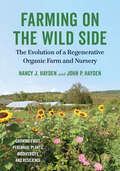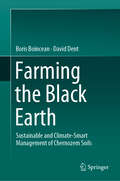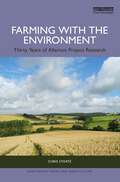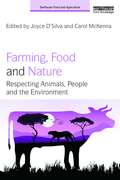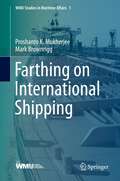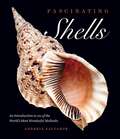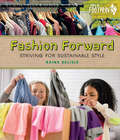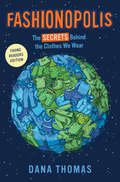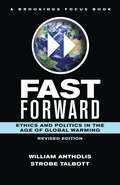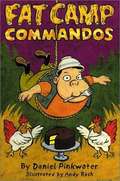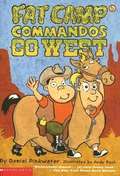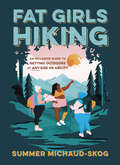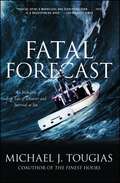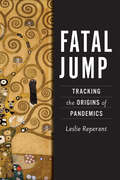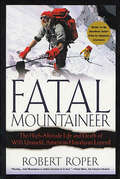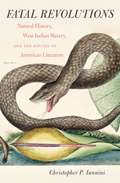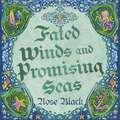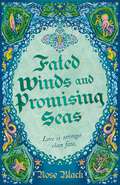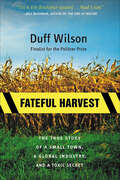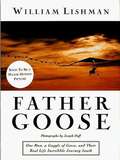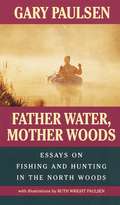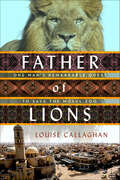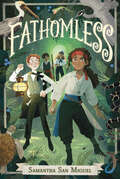- Table View
- List View
Farming on the Wild Side: The Evolution of a Regenerative Organic Farm and Nursery
by Nancy J. Hayden John P. HaydenOne farm&’s decades-long journey into regenerative agriculture—and how these methods enhance biodiversity, pollinators, and soil healthNorthern Vermont&’s Nancy and John Hayden have spent the last 25 years transforming their draft horse–powered, organic vegetable and livestock operation into an agroecological, regenerative, biodiverse, organic fruit farm, fruit nursery, and pollinator sanctuary. In Farming on the Wild Side they explain the philosophical and scientific principles that influenced them as they phased out sheep and potatoes and embraced apples, pears, stone fruits, and a wide variety of uncommon berry crops; turned much of their property into a semi-wild state; and adapted their marketing and sales strategies to the new century. As the Haydens pursued their goals of enhancing biodiversity and regenerating their land, they incorporated agroforestry and permaculture principles into perennial fruit polycultures, a pollinator sanctuary, repurposed greenhouses for growing fruit, hügelkultur, and ecological &“pest&” management. Beyond the practical techniques and tips, this book also inspires readers to develop greater ecological literacy and respect for the mysteries of the global ecosystem. Farming on the Wild Side tells a story about new ways to manage small farms and homesteads, about nurturing land, about ecology, about economics, and about things that we can all do to heal both the land and ourselves.
Farming the Black Earth: Sustainable and Climate-Smart Management of Chernozem Soils (International Year Of Planet Earth Ser.)
by David Dent Boris Boincean'This book deals with the sustainability of agriculture on the Black Earth by drawing on data from long-term field experiments. It emphasises the opportunities for greater food and water security at local and regional levels.The Black Earth, Chernozem in Russian, is the best arable soil in the world and the breadbasket of Europe and North America. It was the focus of scientific study at the very beginnings of soil science in the late 19th century—as a world in itself, created by the roots of the steppe grasses building a water-stable granular structure that holds plentiful water, allows rapid infiltration of rain and snow melt, and free drainage of any surplus.Under the onslaught of industrial farming, Chernozem have undergone profound but largely unnoticed changes with far-reaching consequences—to the point that agriculture on Chernozem is no longer sustainable. The effects of agricultural practices on global warming, the diversion of rainfall away from replenishment of water resources to destructive runoff, and the pollution of streams and groundwater are all pressing issues. Sustainability absolutely requires that these consequences be arrested.
Farming with the Environment: Thirty Years of Allerton Project Research (Earthscan Food and Agriculture)
by Chris StoateThis book examines, discusses and shares over 30 years’ worth of research from the Allerton Project, a research and demonstration farm in the UK which has been carrying out applied interdisciplinary research to explore and explain the need to adapt the management of farmland for environmental protection and to provide public benefits. Designed to provide guidance, feedback and recommendations to farmers, practitioners and policymakers, the Allerton Project is an exceptionally well-documented case study of lowland agricultural land management which has the purpose of meeting multiple objectives. This book draws on the wealth of knowledge built over the past 30 years and unveils and clarifies the complexity of a number of topical debates about current land and wildlife management at a range of spatial scales, explores the underlying historical context and provides some important pointers to future directions of travel. Topics include soil health and management, farmland ecology, development of management practices to enhance biodiversity, natural flood management, water quality and aquatic ecology. Most importantly, the book demonstrates how the findings from this project relate to agricultural and conservation policy more broadly as well as how they are applicable to similar projects throughout Europe. This book will be of great interest to professionals working in agricultural land management and conservation, as well as researchers and students of agri-environmental studies and agricultural policy.
Farming, Food and Nature: Respecting Animals, People and the Environment (Earthscan Food and Agriculture)
by Joyce D'Silva Carol McKennaLivestock production and its use of finite resources is devastating biodiversity and pushing wildlife to the brink of extinction. This powerful book examines the massive global impact caused by intensive livestock production and then explores solutions, ranging from moving to agroecological farming to reducing consumption of animal products, including examples of best practice and innovation, both on land and within the investment and food industries. Leading international contributors spell out the problems in terms of planetary limits, climate change, resources, the massive use of cereals and soy for animal feed, and the direct impact of industrial farming on the welfare of farmed animals. They call for an urgent move to a flourishing food system for the sake of animals, the planet and us. Some offer examples of global good practice in farming or the power of the investment community to drive change, and others highlight food business innovation and exciting developments in protein diversification. Providing a highly accessible overview of key issues, this book creates a timely resource for all concerned about the environmental, social and ethical issues facing food, farming and nature. It will be an invaluable resource and provide inspiration for students, professionals, non-governmental organisations (NGOs) and the general reader.
Farthing on International Shipping
by Mark Brownrigg Proshanto K. MukherjeeThe book provides an introduction to shipping in all its aspects. It is a valuable source of information for students of traditional maritime law as well as for those who seek to understand maritime and shipping services on a global scale. The text includes information and analytical content on national and international practices in shipping, including the age-old dichotomy between freedom in international shipping and the persistent demands of states to control specific maritime areas, as well as the tension between, on the one hand, the desire on the part of sovereign states to regulate and protect their shipping interests and, on the other, the abiding concern and unquestioned right of the international community to regulate the global shipping industry effectively, in order to ensure maritime safety, protection of the environment and fair competition.
Fascinating Shells: An Introduction to 121 of the World’s Most Wonderful Mollusks
by Andreia SalvadorA New Scientist Best Book of the Year Beautiful photographs of stunning shells from London's Natural History Museum, home to one of the most significant and comprehensive collections in the world. Collected and treasured for their beauty, used in religious rituals, or even traded as currency, shells have fascinated humans for millennia. Ancient and enchanting, dazzling in form and variety, these beautiful objects come from mollusks, one of the most diverse groups in the animal kingdom, including snails, oysters, cuttlefish, and chitons. Soft-bodied, these creatures rely on shells for protection from enemies and their environments, from snowy mountains to arid deserts, in deep-sea hydrothermal vents and the jungles of the tropics, on rocky shores, and in coral reefs. In this book, mollusk expert Andreia Salvador profiles some of the world’s most beautiful and quirky shells, each selected from the more than eight million specimens held in the collection at London’s Natural History Museum. We lock eyes with the hundred-eyed cowry, named after "the all-seeing one," the giant Argus Panoptes of Greek mythology. We see how shells' appearances translate into defense strategies, as with the zigzag nerite, which varies its patterning to deceive and confuse predators. And we meet shell inhabitants, such as the amber snail, which eats earthworms by sucking them up like spaghetti. Reproduced in full color and striking detail, these shells have much to reveal about the history of collecting, the science of taxonomy, and the human desire to understand the natural world.
Fashion Forward: Striving for Sustainable Style (Orca Footprints #22)
by Raina DelisleFashion can be fun, but it can also hurt people, animals and the planet. Fashion Forward: Striving for Sustainable Style goes behind the glitz and glamour to explore the social and environmental issues within the fashion industry. It looks at the history of fashion, from why humans started wearing clothes to the birth of consumerism to the explosion of fast fashion and fashion’s footprint. The book introduces readers to the innovative people, companies and organizations that are taking positive action on fashion. Kids will discover how to make ethical choices and become fashion heroes for the future. There are easy ways we can help transform the fashion industry and still look stylish at the same time! The epub edition of this title is fully accessible.
Fashionopolis (Young Readers Edition): The Secrets Behind the Clothes We Wear
by Dana ThomasA look at fast fashion and its impact on the environment and social justice, perfect for middle grade classroomsDid you ever think about where your jeans come from? How about the people who made your T-shirt, or what happens to the clothes you grow out of when you're done wearing them? The fabrics clothes are made of, the way they are designed and sewn and shipped around the world, and the way we consume them and get rid of them--every step in this process has a big impact on our environment, on the people who work in clothing factories, and on our cultures. This nonfiction book shows us how the clothes we wear--and throw away--every day are made, and what that means for our planet and for people around the world.
Fast Forward
by Strobe Talbott William AntholisFast Forward is equal parts science primer, history lesson, policy prescription, and ethical treatise. This pithy and compelling book makes clear what we know and don't know about global warming; why the threat demands prudent and urgent action; why the transition to a low-carbon economy will be the most difficult political and economic transaction in history; and how it requires nothing less than a revolution in our sense of civic responsibility. William Antholis and Strobe Talbott guide the reader through two decades of climate change politics and diplomacy, explaining the national and international factors that have influenced and often impeded domestic climate legislation and global negotiations. Recent United Nations-sponsored summits have demonstrated that the world cannot wait for a binding global treaty. Instead, the authors believe that the "Big Four" of America, the European Union, China, and India must lead the way forward. They recommend a new international mechanism modeled on the General Agreement on Tariffs and Trade that would monitor national commitments and create incentives for other countries to coordinate their efforts to cut emissions.Antholis and Talbott put their recommendations for legislative and diplomatic action into the larger context of our obligation to future generations, echoing a theme stressed by a diverse coalition of religious leaders calling for ambitious action on climate change. The world we leave to our children and grandchildren is not an abstraction, or even just a legacy; we must think about what kind of world that will be in deciding how we live-and act-today.
Fast-Forward
by Ben D. Van Roo Keenan D. Yoho Richard HillestadEfficient movement of freight within the United States and across its borders is a critical enabler of future U.S. economic growth. The authors provide an overview of the freight-transportation system and the problems it faces, concluding with a discussion of key system-modernization issues, including increasing capacity, making the system less vulnerable to disruption, addressing environmental concerns, and building support for funding.
Fat Camp Commandos
by Daniel PinkwaterKids of all sizes think about being fat or thin or in between. This book is about kids sent to camp to lose weight. Could you go to a camp where the sugarless syrup on the one pancake you get tastes like mouthwash? The camp is in Mountainburg. Home of fortune-telling chickens, the infamous Tator Family, and Camp Noo Yoo. Yes, Camp Noo Yoo, where frantic parents send their pudgy little darlings in hopes that a diet of shredded carrots with raisins will turn them into pre-adolescent fashion plates. Or at least help them shed a few of those socially unacceptable extra pounds. Fed up with the jeering and abuse at Camp Noo Yoo, Ralph and Sylvia Nebula and their new friend, Mavis Goldfarb, hop a bus back home to Pokooksie. There, they seek revenge. Revenge on their parents. Revenge on Dr. Frizzbender, founder of Anti-Fat Day. And revenge on Richard "Dick" Tator, the overweight and overbearing owner of Camp Noo Yoo. Enter the world of Pinkwater, where size is not an obstacle, but a source of strength, and where your favorite poison, be it a Twinkie, a Krispy Kreme doughnut, or a banana split, is always at arms reach. This book may have the shortest chapters in history. There are 62 chapters in 89 pages. Chapter 15 is only 10 words long. Chapter 55 is so short that it's completely missing. Read this book with someone you love--and treat yourself to cookies and milk while you're at it.
Fat Camp Commandos Go West
by Daniel PinkwaterSaddle up, cowpokes, and get ready for the Wild, Wild West! Ralph, Sylvia, and Mavis, the pudgy pranksters from FAT CAMP COMMANDOS, are back -- and this time they are out to shake up the sleepy Western town of Horny Toad.
Fat Girls Hiking: An Inclusive Guide to Getting Outdoors at Any Size or Ability
by Summer Michaud-Skog&“An invaluable guide…Kudos to the author for changing the narrative on inclusiveness, breaking down stereotypes, and building body positivity.&” —Booklist From the founder of the Fat Girls Hiking community comes an inclusive, inspiring call to the outdoors for people of all body types, sizes, and backgrounds. In a book brimming with heartfelt stories, practical advice, personal profiles of Fat Girls Hiking community members, and helpful trail reviews, Summer Michaud-Skog creates space for marginalized bodies with an insistent conviction that outdoor recreation should welcome everyone. Whether you&’re an experienced or aspiring hiker, you&’ll be empowered to hit the trails and find yourself in nature. Trails not scales!
Fatal Forecast
by Michael J. TougiasA true story of catastrophe and survival at sea, Fatal Forecast is a spellbinding moment-by-moment account of seventy-two hours in the lives of eight young fishermen, some of whom would never set foot on dry land again. On the morning of November 21, 1980, two small Massachusetts lobster boats set out for Georges Bank, a bountiful but perilous fishing ground 130 miles off the coast of Cape Cod. The National Weather Service had forecast typical fall weather, and the young, rugged crewmen aboard the Sea Fever and the Fair Wind had made dozens of similar trips that season. They had no reason to expect that this trip would be any different. But the only weather buoy on Georges Bank was malfunctioning, and the National Weather Service had failed to share this fact with the fishermen who depended on its forecasts. As the two small boats headed out to sea, a colossal storm was brewing to the southeast, a furious maelstrom the National Weather Service did not accurately locate until the boats were already caught in the storm's grip, trapped in the treacherous waters of Georges Bank. Battered by sixty-foot waves and hurricane-force winds, the crews of the Fair Wind and the Sea Fever (captained by Peter Brown, whose father owned the Andrea Gail of Perfect Storm fame) struggled heroically to keep their vessels afloat. But the storm soon severely crippled one boat and overturned the other, trapping its crew inside. Meticulously researched and vividly told, Fatal Forecast is first and foremost a tale of miraculous survival. Most amazing is the story of Ernie Hazzard, who managed to crawl inside a tiny inflatable life raft and then spent more than fifty terrifying hours adrift on the stormy open sea. By turns tragic, thrilling, and inspiring, Ernie's story deserves a place among the greatest survival tales ever told. Equally riveting are the stories of the brave men and women from the Coast Guard and the crew of a nearby fishing boat who imperiled their own lives that day in order to save the lives of others. As gripping and harrowing as The Perfect Storm - but with a miracle ending - Fatal Forecast is an unforgettable true story about the collision of two spectacular forces: the brutality of nature and the human will to survive.
Fatal Jump: Tracking the Origins of Pandemics
by Leslie ReperantExploring the fateful chains of events that gave rise to humanity's infectious diseases and pandemics.Why do global pandemics materialize? To address this question, we must delve into the world of pathogens that transcend their original host species and jump into new ones. Most pathogens fail to initiate infection or spread in the population when they jump. Only a few sustain onward chains of transmission, and even fewer sustain these indefinitely. Yet the rare pathogens that do make the leap have caused many of humanity's most dangerous infectious diseases.In Fatal Jump: Tracking the Origins of Pandemics, veterinary disease ecologist Dr. Leslie Reperant investigates mysteries such as how African-originated monkeypox left its home continent, why COVID-19 could threaten measles control, and how pigs' fondness for mangoes enabled the deadly Nipah virus to spread. She shares behind-the-scenes insights into hugely destructive pathogens carried by rats, bats, ticks, and mosquitoes, as well as lesser-known vectors such as prairie dogs and camels. Drawing from the latest research, she discusses whether we can predict these deadly jumps before they happen and what factors—including environmental change, population dynamics, and molecular evolution—enable a zoonotic disease to reach full pandemic status. Rich with recent scientific discoveries and emerging theories, this book spans a diverse range of disciplines, weaving their insights into a holistic view of infectious disease.With new pathogens emerging at an alarming pace, Fatal Jump reorients our perspective on pandemics from a human-centered standpoint to the bigger picture. We will understand what actions are necessary to control emergence only by recognizing the increasingly global nature of human society and the connections between the planet's environmental health and our own health.
Fatal Mountaineer: The High-Altitude Life and Death of Willi Unsoeld, American Himalayan Legend
by Robert RoperRobert Roper's Fatal Mountaineer is a gripping look at Willi Unsoeld and the epic climbs that defined him--a classic narrative blending action with ethics, fame with tragedy, a man's ambition with a father's anguish.In 1963, Willi Unsoeld became an international hero for his conquest of the West Ridge of Everest. A charismatic professor of philosophy, Unsoeld was one of the greatest climbers of the twentieth century, a man whose raw physical power and casual fearlessness inspired a generation of adventurers. In 1976, during an expedition to Nanda Devi, the tallest peak in India, Unsoeld's philosophy of spiritual growth through mortal risk was tragically tested. The outcome of that expedition continues to fuel one of the most fascinating debates in mountaineering history.
Fatal Revolutions
by Christopher P. IanniniDrawing on letters, illustrations, engravings, and neglected manuscripts, Christopher Iannini connects two dramatic transformations in the eighteenth-century Atlantic world--the emergence and growth of the Caribbean plantation system and the rise of natural science. Iannini argues that these transformations were not only deeply interconnected, but that together they established conditions fundamental to the development of a distinctive literary culture in the early Americas. In fact, eighteenth-century natural history as a literary genre largely took its shape from its practice in the Caribbean, an oft-studied region that was a prime source of wealth for all of Europe and the Americas. The formal evolution of colonial prose narrative, Ianinni argues, was contingent upon the emergence of natural history writing, which itself emerged necessarily from within the context of Atlantic slavery and the production of tropical commodities. As he reestablishes the history of cultural exchange between the Caribbean and North America, Ianinni recovers the importance of the West Indies in the formation of American literary and intellectual culture as well as its place in assessing the moral implications of colonial slavery.
Fated Winds and Promising Seas: A tender-hearted tale of forging fates, fantastic creatures, and found family
by Rose Black'An absolute bear-hug of a book!' SANGU MANDANNAWhen a promise is made, a fate is woven.Imprisoned for a crime he cannot remember committing, Lucky is more comfortable with the four walls of his cell than the world outside. That is until he's ripped free from his prison and swept out into the ocean. . . and rescued by The Dreamer.But The Dreamer is no ordinary vessel, with its crew of outcasts and heretics who possess the ability to manipulate water. Lucky is taken under the protective wing of a sailor named Gabriel, but when he recognises Gabriel from his past, Lucky suspects it may not be a simple accident that threw them together.To understand their connection and prove Lucky's innocence, they must navigate treacherous waters, avoid giant Leviathan, and outwit those seeking to arrest them. But some memories hide secrets that could destroy all that they love. And with the tides of fortune ever-changing, the quest for freedom is just the beginning. Fated Winds and Promising Seas is a queer fantasy, perfect for fans of Legends and Lattes and Nettle and Bone.THEMES AND TROPES! Mental health rep, MM romance, found family, magical ships, safe and cared for, sharing the same room, gay romance novel, happily ever after!READER REVIEWS FOR TIL DEATH DO US BARD:'THIS IS EVERYTHING!' ⭐⭐⭐⭐⭐'Joyous, uplifting, heart warming' ⭐⭐⭐⭐⭐'The romance, the adventure, the cast of characters. Every time I think about this book it puts a smile on my face' ⭐⭐⭐⭐⭐'This book felt like a cozy game of D&D with a side of romance and I loved every minute of it!' ⭐⭐⭐⭐⭐'I highly recommend this to anyone who likes cozy fantasy, D&D and/or Our Flag Means Death!' ⭐⭐⭐⭐⭐'Sometimes you just find a book where you see the cover, find it intriguing, read the synopsis, find that even more intriguing and then you read the book and it's everything you wanted' ⭐⭐⭐⭐⭐
Fated Winds and Promising Seas: A tender-hearted tale of forging fates, fantastic creatures, and found family
by Rose Black'An absolute bear-hug of a book!' SANGU MANDANNAWhen a promise is made, a fate is woven.Imprisoned for a crime he cannot remember committing, Lucky is more comfortable with the four walls of his cell than the world outside. That is until he's ripped free from his prison and swept out into the ocean. . . and rescued by The Dreamer.But The Dreamer is no ordinary vessel, with its crew of outcasts and heretics who possess the ability to manipulate water. Lucky is taken under the protective wing of a sailor named Gabriel, but when he recognises Gabriel from his past, Lucky suspects it may not be a simple accident that threw them together.To understand their connection and prove Lucky's innocence, they must navigate treacherous waters, avoid giant Leviathan, and outwit those seeking to arrest them. But some memories hide secrets that could destroy all that they love. And with the tides of fortune ever-changing, the quest for freedom is just the beginning. Fated Winds and Promising Seas is a queer fantasy, perfect for fans of Legends and Lattes and Nettle and Bone.THEMES AND TROPES! Mental health rep, MM romance, found family, magical ships, safe and cared for, sharing the same room, gay romance novel, happily ever after!READER REVIEWS FOR TIL DEATH DO US BARD:'THIS IS EVERYTHING!' ⭐⭐⭐⭐⭐'Joyous, uplifting, heart warming' ⭐⭐⭐⭐⭐'The romance, the adventure, the cast of characters. Every time I think about this book it puts a smile on my face' ⭐⭐⭐⭐⭐'This book felt like a cozy game of D&D with a side of romance and I loved every minute of it!' ⭐⭐⭐⭐⭐'I highly recommend this to anyone who likes cozy fantasy, D&D and/or Our Flag Means Death!' ⭐⭐⭐⭐⭐'Sometimes you just find a book where you see the cover, find it intriguing, read the synopsis, find that even more intriguing and then you read the book and it's everything you wanted' ⭐⭐⭐⭐⭐
Fated Winds and Promising Seas: A tender-hearted tale of forging fates, fantastic creatures, and found family
by Rose Black'An absolute bear-hug of a book!' SANGU MANDANNAWhen a promise is made, a fate is woven.Imprisoned for a crime he cannot remember committing, Lucky is more comfortable with the four walls of his cell than the world outside. That is until he's ripped free from his prison and swept out into the ocean. . . and rescued by The Dreamer.But The Dreamer is no ordinary vessel, with its crew of outcasts and heretics who possess the ability to manipulate water. Lucky is taken under the protective wing of a sailor named Gabriel, but when he recognises Gabriel from his past, Lucky suspects it may not be a simple accident that threw them together.To understand their connection and prove Lucky's innocence, they must navigate treacherous waters, avoid giant Leviathan, and outwit those seeking to arrest them. But some memories hide secrets that could destroy all that they love. And with the tides of fortune ever-changing, the quest for freedom is just the beginning. Fated Winds and Promising Seas is a queer fantasy, perfect for fans of Legends and Lattes and Nettle and Bone.THEMES AND TROPES! Mental health rep, MM romance, found family, magical ships, safe and cared for, sharing the same room, gay romance novel, happily ever after!READER REVIEWS FOR TIL DEATH DO US BARD:'THIS IS EVERYTHING!' ⭐⭐⭐⭐⭐'Joyous, uplifting, heart warming' ⭐⭐⭐⭐⭐'The romance, the adventure, the cast of characters. Every time I think about this book it puts a smile on my face' ⭐⭐⭐⭐⭐'This book felt like a cozy game of D&D with a side of romance and I loved every minute of it!' ⭐⭐⭐⭐⭐'I highly recommend this to anyone who likes cozy fantasy, D&D and/or Our Flag Means Death!' ⭐⭐⭐⭐⭐'Sometimes you just find a book where you see the cover, find it intriguing, read the synopsis, find that even more intriguing and then you read the book and it's everything you wanted' ⭐⭐⭐⭐⭐
Fateful Harvest: The True Story of a Small Town, a Global Industry, and a Toxic Secret
by Duff WilsonI see soil in a new light, and I wonder about my own lawn and garden. What have I sprinkled on my backyard? Is somebody using my home, my food, to recycle toxic waste? It seems unbelievable, outlandish -- but what if it's true?A riveting expose, Fateful Harvest tells the story of Patty Martin -- the mayor of a small Washington town called Quincy -- who discovers American industries are dumping toxic waste into farmers' fields and home gardens by labeling it "fertilizer." She becomes outraged at the failed crops, sick horses, and rare diseases in her town, as well as the threats to her children's health. Yet, when she blows the whistle on a nationwide problem, Patty Martin is nearly run out of town.Duff Wilson, whose Seattle Times series on this story was a finalist for the Pulitzer Prize, provides the definitive account of a new and alarming environmental scandal. Fateful Harvest is a gripping study of corruption and courage, of recklessness and reckoning. It is a story that speaks to the greatest fears -- and ultimate hope -- in us all.
Father Goose: One Man, a Gaggle of Geese and Their Real Life Incredible Journey South
by William Lishman Joseph DuffFeatured on an enormously popular 20/20 segment, this heartwarming story tells of William Lishman, a reclusive sculptor, who adopted a gaggle of geese, flew with them in an ultralight glider, and actually taught them to migrate--earning himself the nickname "Father Goose. "
Father Water, Mother Woods: Essays on Fishing and Hunting in the North Woods
by Gary Paulsen Ruth Wright PaulsenSurvival in the wilderness--Gary Paulsen writes about it so powerfully in his novels Hatchet and The River because he's lived it. These essays recount his adventures alone and with friends, along the rivers and in the woods of northern Minnesota. There, fishing and hunting are serious business, requiring skill, secrets, and inspiration. Luck, too--not every big one gets away.This book takes readers through the seasons, from the incredible taste of a spring fish fresh from the smokehouse, to the first sight of the first deer, to the peace of the winter days spent dreaming by the stove in a fishhouse on the ice. In Paulsen's north country, every expedition is a major one, and often hilarious.Once again Gary Paulsen demonstrates why he is one of America's most beloved writers, for he shows us fishing and hunting as pleasure, as art, as companionship, and as sources of life's deepest lessons.From the Paperback edition.
Father of Lions: One Man's Remarkable Quest to Save the Mosul Zoo
by Louise CallaghanFather of Lions is the powerful true story of the evacuation of the Mosul Zoo, featuring Abu Laith the zookeeper, Simba the lion cub, Lula the bear, and countless others, faithfully depicted by acclaimed, award-winning journalist Louise Callaghan in her trade publishing debut.Combining a true-to-life narrative of humanity in the wake of war with the heartstring-tugging account of rescued animals, Father of Lions will appeal to audiences of bestsellers like The Zookeeper’s Wife and The Bookseller of Kabul as well as fans of true animal stories such as A Streetcat Named Bob, Marley and Me, and Finding Atticus.“An unexpectedly funny and moving book. ... Through the story of a man who loves both lions and life, Louise Callaghan shows how humour and defiance can counter cruelty, and why both humans and animals crave freedom.” -- Lindsey Hilsum, International Editor, Channel 4 News and author of In Extremis: the life of war correspondent Marie Colvin.At the Publisher's request, this title is being sold without Digital Rights Management Software (DRM) applied.
Fathomless (Spineless)
by Samantha San Miguel&“Pure storytelling at its best.&”—Kirkus Reviews, Starred Review Ghostly pirates, lost treasure, and high adventure abound in Fathomless, the sequel to Spineless, set in glittering Gilded Age Florida. After months away at boarding school, Lulu Davenport was looking forward to summer vacation at her home on the southwest Florida coast, especially since her best friend, Algie Emsworth, will be spending his vacation with the Davenport family. But since his widowed mother has fallen on hard times, he&’s gotten a job nearby that keeps him away from the house most of the day. And Frankie, Lulu&’s sister and usual companion, is out of commission after injuring herself while sailing. But when Lulu hears about a possible haunting in a nearby abandoned fort and rumors of hidden treasure, she decides it&’s time to strike out on her own and solve the mystery herself. In the process, she meets Vic, a blind boy who&’s just moved to town, and the two of them embark on a hunt for clues about the ghostly appearances. Soon enough, Frankie and Algie join them, and the four friends uncover all sorts of very real dastardly deeds going on, and the villain is much closer to home than they expected!Fathomless is full of hijinks, mystery, and heart, as Samantha San Miguel brings readers into the wild and wonderful world of nineteenth century Florida in this sparkling sequel to Spineless.
